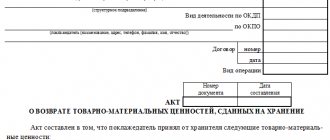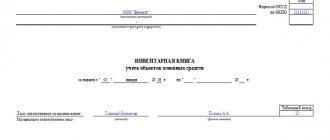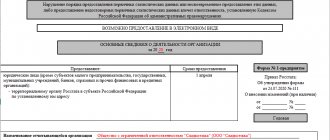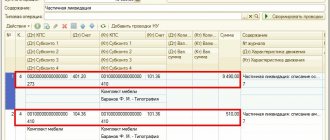What are fixed assets
Fixed assets include any property of an enterprise used to carry out its activities: these can be materials, machinery, instruments, equipment, etc., in other words, everything that is involved in the labor process.
It should be noted that any inventory items acquired by an organization for work must be listed on its balance sheet. Once materials, equipment or machinery become unusable, they must be written off.
Read more about the article: what are fixed assets?
Who is required to fill out and submit the 4-OS report?
Those who must submit Form 4-OS include the following subjects:
- Entrepreneurial activities – legal entities and individuals;
- Those who operate funds of environmental significance, as well as objects that harm the environment;
- Implementing measures aimed at protecting the atmosphere, water and subsoil from negative impacts from these or other objects.
According to the old order (dated August 24, 2017 No. 545), the list of persons who are required to submit Form 4-OS included all the same entities that operate wastewater treatment plants.
The combination of all these factors obliges such entities to fill out the specified form and submit it to the regulatory authorities in a timely manner. This should be done not only by domestic entities, but also by branches of foreign companies, their branches that officially operate in Russia.
It is important to know! The amount of expenses for environmental protection measures must be at least 100 thousand rubles. This includes the cost of services with a similar purpose.
Form 4-OS is completed and submitted for the reporting period until January 25 of the following year. The document is sent to the territorial body of Rosstat. Here you can see a sample of filling out form 4-OS with an example.
Report form on form 4=OS (374 Downloads) Instructions for filling out a report on form 4-OS (275 Downloads)
Procedure
In order to write off fixed assets, it is necessary to first establish their unsuitability for further use. For this purpose, the company creates a special commission, the main task of which is to certify the fact of a defect, wear, etc.
The commission must include at least three people, including the financially responsible person.
Most often, only full-time employees of the enterprise are included in the commission, but in some cases, these may also be third-party experts who have the necessary knowledge and skills to determine irreparable failure, for example, of particularly complex equipment.
After the property is declared completely faulty, the commission draws up a special act, on the basis of which the organization writes an order to write off fixed assets. This order, in turn, serves as the basis for drawing up a write-off act.
How to fill out form 4-OS
Completing 4-OS reporting is regulated by Rosstat Order No. 412 dated July 18, 2019. A sample form and instructions for filling out are in Appendix 4 to the Order.
Report separately for branches and the parent company, but only if there is an event. If there is nothing to contribute to 4-OS, do not submit anything. Submit the completed report to the territorial Rosstat on paper or electronically.
4-OS includes a title page and a table. Let's look at them in order.
Keep records of exports and imports in the Kontur.Accounting web service. Simple accounting, payroll and reporting in one service
How to draw up an act correctly
Today, the act of writing off fixed assets can be written in any form, however, most enterprise employees, in the old fashioned way, prefer to use previously generally applicable mandatory forms in their work. Their advantage is obvious: there is no need to rack your brains over the structure and content of the document, since all the necessary positions are indicated in it. Such unified forms also include form OS-4. This act can be filled out both when writing off one object or several at once.
conclusions
Several main points can be highlighted on this topic:
- To write off fixed assets, the company must draw up a corresponding act.
- The form can be drawn up in free form. However, there is a unified form OS-4.
- The act must contain three blocks: information about the condition of the object being written off, its characteristics and information about costs.
- The document is drawn up by a specially created commission, approved by order of the director of the enterprise.
- The act can be drawn up by hand or printed on a computer. The signatures, however, must all be living.
- A document is drawn up in the amount of two pieces.
- The act must indicate the reason for writing off the company’s property, that is, the fact that it is unsuitable for use.
- When written off, the amount of loss for the enterprise in monetary terms is reflected in a separate line of the act.
Sample of filling out the OS-4 form
- At the beginning of the document, on its front side, the following is indicated:
- name of company,
- her TIN,
- checkpoint,
- the structural unit to which the written-off fixed asset belongs.
- Next, the basis for the write-off is written - here you need to put a link to some supporting document (usually an order from the manager) and the financially responsible person (only the employee’s full name is written here).
- On the right side of the form enter:
- OKPO code of the company (can be found in the constituent documents),
- date of write-off of fixed assets from accounting,
- number and date of issue of the document that became the basis for write-off,
- personnel number of the financially responsible employee.
- Below is the document number, the date it was compiled, and the reason for the write-off.
- On the right is a place for approval of the act by the director of the enterprise.
The next part is presented in the form of a table and relates directly to the property being written off:
- in the first column,
- in the second and third - inventory and serial numbers, respectively,
- on the fourth or fifth date of release of the product and the date of its acceptance onto the balance sheet of the organization.
- in the sixth column (i.e., the time that the property was actively used in work),
- in the seventh - the cost of the object at the time of its acceptance for accounting,
- in the eighth - the amount of accrued depreciation,
- in the ninth - residual value (the value in the last paragraph is the difference in indicators from the two previous columns).
Who fills it out?
Before decommissioning an object, it is inspected, upon which an inspection report is drawn up.
When the OS is confirmed to be unsuitable for use, the write-off process is launched and a corresponding report is issued.
It is also compiled by the commission that conducted the property survey.
The commission for writing off assets must include at least 3 people.
This may include heads of various departments and third-party experts.
The document is issued only after a thorough inspection of the written-off fixed asset. All commission members must affix their visas to the document.
If one of them does not want to sign, a special note is made about this.
write-off act:
- motor transport - OS-4a;
- groups of objects - OS-4.
Filling procedure
The act can be filled out in any form or in the form approved by the company. But, most companies use the unified OS-4 form.
Such an act can be filled out for one or several objects at once.
Basic rules for filling out the OS-4 form:
The top of the form includes the following information:
- Company name;
- form code;
- grounds for drawing up the paper;
- the write-off date is indicated;
- FULL NAME. mat. responsible person;
- Director's visa and signature date.
The main part of the form should consist of 3 tables. Before each of them you need to write down the reason for writing off the object.
Let’s say: the fixed asset is outdated, incorrect operation of the equipment, damage as a result of an accident, etc. The contents of the tables should be as follows:
| Information about the state of the object being written off |
|
| OS characteristics |
|
| Cost information |
|
Under the second table are the conclusions of the commission members about the results of the inspection of the OS. The accompanying documents are also listed here and the composition of the commission is prescribed.
Under the final table, the results of the write-off are written down in detail, and the visa of the chief accountant is also affixed.
The act can be filled out by hand or printed on a computer (other printing equipment).
Important! The signatures of the commission members and the director must be “living” (original).
When the OS-4 form is filled out manually, a black or blue ballpoint pen is used. Using a pencil to fill out a document is unacceptable. Errors and corrections in such documentation are not permitted.
It is not necessary to put a company seal. No stamps are needed here either. But only if such a condition is not specified in the company’s local documentation.
The unified form OS-4 is compiled in two pieces. One of them is transferred to the accounting department. Based on it, the department employee reflects the write-off and transfers it to the warehouse for disposal.
If necessary, you can make copies of the document.
Examples of reasons for disposal of an asset
The reasons for writing off a fixed asset can be varied.
The main reasons for disposal are:
- the main tool is outdated,
- the object was subject to improper operation,
- The OS is damaged as a result of accidents, natural disasters or fire,
- the operating time of the facility has been completed and under other similar circumstances.
What to write in the line “write-off results”
The line about the results of the write-off indicates the monetary value of the loss as a result of the deregistration of the fixed asset. Let’s say “the loss is two thousand rubles.”
Download free form and sample in word
Download the standard form of the act of the unified form OS-4 – word, excel.
filling out the statement of write-off of fixed assets OS-4 – excel.
Sample of filling out the reverse side of the OS-4 form
The reverse side of the act also contains two tables. The first contains individual parameters that serve as part of the characteristics of the object, including information about the content of precious metals.
Below the table there are several lines in which the commission taking part in the write-off of fixed assets makes its conclusion (in this case, on the write-off).
If necessary, a list of additional documents accompanying this act is indicated.
Then the commission puts its signatures next to the indicated positions with their full names.
The last table includes information about:
- expenses incurred for write-off of fixed assets,
- remaining inventory items suitable for further use,
- funds proceeds from the sale of written-off property.
Finally, the act is certified by the signature of the organization’s chief accountant.
An example of filling out an act for writing off groups of fixed assets
On March 29, 2019, the inventory commission found unused printers in the Office division of Mir Production LLC (replaced with new high-performance MFPs).
By order of the director dated April 1, 2019 No. 5, it was decided to sell the discovered printers.
Act on write-off of fixed assets (group of printers) dated 04/05/2019 No. 2 was drawn up on the basis of:
- inventory cards for printers;
- inventory act dated March 29, 2019;
- act of purchase and sale of printers dated 04/05/2019 No. 12.
The completed sample act is posted below:
How to correctly draw up an act of write-off of fixed assets in the OS-4 form
The act can be filled out manually or on a computer.
There is only one important condition: it must contain the original signatures of the head of the enterprise, as well as members of the write-off commission.
There is no strict need to certify the form with a seal - as of 2021, legal entities are exempted by law from the obligation to use various types of cliches and stamps in their work.
The act is drawn up in at least two copies :
- one of which is transferred to the accounting department of the enterprise, so that in the future, on its basis, the accountant can reflect the write-off of the property specified in the act,
- the second remains with the financially responsible person, who then gives it to the warehouse in order to either dispose of the fixed asset or sell it.
If necessary, additional copies of the act can be created.
Equipment decommissioning
It is recommended to carry out write-offs annually for proper control of production capacity. As described above, only a special commission, which will include a deputy manager, economist, accountant, and workers, has the right to write off equipment.
Material assets are written off for the following reasons:
- unfit for work;
- sale of an asset;
- liquidation after an emergency;
- do not exist at the time of inventory;
- morally or physically obsolete;
- complete wear and tear;
- damage beyond repair;
- transfer to another organization in the form of a capital contribution;
- partial liquidation after reconstruction.
Physical wear and tear results in loss of original value. Occurs during equipment operation or due to damage from fires, floods, etc.
Obsolescence – aging due to the release of improved analogues. Worn-out equipment must be written off, justified and supported by documents. To determine the possibility of further use of the equipment, another commission is appointed. For equipment that has become unusable, the OS-4 form is used.
It is important to indicate the date of preparation in the act and mention the past inventory.
Write-off rules:
- Determination of the technical condition of each object separately.
- Preparation of documentation indicating equipment that has failed.
- Drawing up an equipment write-off act.
- Permission from the director of the organization to write off objects.
- Dismantling, disposal.
- Deregistration of an object.
From the attached documents the general condition of the equipment, any deficiencies found and the likelihood of their elimination through repairs should be clear.
The write-off act consists of:
- Obtain prime costs for further formation of the price of the product.
- Justify the costs of taxation of the enterprise.
- Confirm the asset indicator when transferring it to the balance sheet of another organization.
As you can see, the technical condition of the equipment is important in many respects. It is permissible to write off only assets that are unsuitable for further use due to damage and loss of important qualities.
The equipment write-off act is drawn up in two copies: for the financially responsible person and the accountant. Be sure to indicate:
- Date of write-off (drawing up the act).
- Cost (must correspond to receipt documents).
- The document that serves as the basis for write-off.
Draw up an act in writing. The form is not regulated, they use TORG-16. The main part indicates the reasons for the write-off. At the end, the commission must make a final decision and sign the document.
To write off equipment, a previously drawn up technical condition report is required. It is filled out by a commission of competent specialists appointed by the director. The act is drawn up according to the approved model in a certain sequence. The people who signed it are responsible for the information provided. In case of deliberate distortion of data, the perpetrators fall under administrative or criminal liability.
Sample according to OKUD form 0504143
Form OKUD 0504143 in the form of a table
Sample OKUD act 0504230
Form OKUD 0504230 in the form of a table
Basis for compilation
The basis for compilation may be:
- an inventory was carried out, during which it became clear that some of the accounting objects needed to be disposed of;
- initiative of persons responsible for the use of values (PRO).
The reason for writing off materials in the write-off act depends on what kind of material assets are supposed to be written off. For example, the disposal of soft equipment may be due to the wear and tear of the item, stationery must be transferred according to a statement from the MOL to the direct user (statement for issuing valuables for the needs of the institution according to form 0504210), dishes are entered according to the tableware breakage registration book (form code 0504044). In case of destruction of inventory items, approved documents must be attached.
Responsible persons are members of the commission for the receipt and disposal of assets. They are appointed by order of the head of the institution.
Peculiarities
If the SPI of an asset has not yet expired, and operation for various reasons is no longer possible, it must be written off. Liquidation costs can be included in non-operating expenses.
According to the norms of the Tax Code of the Russian Federation, it is necessary to take into account some nuances:
- the residual value of fixed assets reduces income tax, but is taken into account in expenses differently, depending on the depreciation method;
- the decision to dismantle the facility is made by order of the director;
- if dismantling is not necessary in principle, for example, the asset burned down in a fire, the primary documents are used to document the removal of garbage, otherwise the Federal Tax Service will consider that the liquidation was not carried out.
VAT
In the letter of the Federal Tax Service of the Russian Federation dated April 16, 2018 N SD [email protected], based on the position of the Supreme Arbitration Court, it was concluded that the tax amounts previously accepted for deduction on acquired assets written off with depreciation of less than 100% do not need to be restored.
Organizations that do not have a license often have questions about the sale of scrap metal and accounting for the corresponding income generated from the write-off of fixed assets.
Such transactions are not subject to VAT.
This is stated in the letter of the Ministry of Finance of the Russian Federation dated 09/02/2015 N 03-07-07_50555, which classifies as an exception the situation with the sale of scrap metal obtained as a result of dismantling one’s own OS.
Income tax
There are two grounds for removing an asset from the balance sheet, which directly affect the calculation of the tax base:
- upon liquidation, dismantling costs and the difference between the initial price and accrued depreciation are included in costs that reduce taxable profit;
- upon sale, proceeds are reduced by costs associated with sales and residual value.
Who inspects the equipment?
In order to conduct a more detailed inspection of a fixed asset (usually this concerns equipment), a commission is created.
It consists of company employees working in different departments.
As a rule, these are middle-level managers: leading engineers, technologists or deputy directors.
It may also include lawyers or accountants.
Specialists of different profiles can describe equipment from different angles.
The commission is appointed by the head of the company by order.
Additionally, it must indicate the main person - the chairman.
All members must be present at the inspection and sign the relevant document.
The law does not approve a special form for the inspection report of fixed assets before write-off. Therefore, companies can draw it up in free form or according to a model approved by the manager.
It is allowed to draw up the document on a regular white piece of paper in A-4 format. You can fill out the form by hand or print it on a computer.
However, the signatures of all commission members here must be exclusively “live”.
If you refuse to apply for a visa, you need to make a note about this, and additionally indicate the reason for the refusal.
If the act is written by hand, then this is done with a blue or black pen; it is strictly forbidden to use a simple pencil.
The act is drawn up in two pieces. If necessary, the document can be photocopied and certified.
The document header consists of the following information:
- name of the enterprise;
- Title of the document;
- place of execution of the document and date.
The main part contains the data:
- composition of the commission: position and full name. participant;
- the chairman is allocated separately;
- name of the fixed asset, model, article number, inventory number, characteristics and location address;
- actions carried out during OS inspection (equipment startup, installation, measurements, etc.);
- detailed inspection results;
- the result of the commission’s work, the conclusions of each member.
Next, the signatures of all members of the commission are affixed based on the results of the inspection of the OS facility.
When photographs and video footage are attached to the act, their presence must be indicated in it as a separate paragraph. If necessary, the document is supplemented with other important data.
It is not allowed to contain clerical errors or errors in the act; corrections cannot be made, otherwise the document will lose its significance.
act of inspection of an OS object for its further write-off –word.
Several main conclusions can be drawn on this topic:
- Before writing off a fixed asset, it must be inspected, for which a special report is drawn up.
- The examination is carried out by a special commission created in the company and approved by order of the manager.
- The procedure is carried out in several main stages: data collection and preliminary inspection, analysis (if necessary), detailed study of the OS object.
- The act does not have a special unified form and can be drawn up in free form or according to the approved form of the company.
- The document cannot contain errors or corrections.
- It is allowed to attach additional materials to the act, which is specified in the document as a separate paragraph.
- The form is drawn up in duplicate and can be reproduced in copies if necessary.
Features when filling out the 4-OS report
There are some specifics on how to fill out the 4-OS report in different cases.
As stated above, it is provided separately for each branch. This also applies to other separate divisions.
But there are exceptions when one report is submitted for branches. Allowed in the following cases:
- They are located at the same legal or actual address;
- Their addresses are different, but the branches are located in close proximity to each other, and their activities are closely interconnected.
A branch or separate subdivision is any part of an enterprise equipped with stationary workplaces, which is located separately from the head office.
It is allowed that a report in Form 4-OS for separate divisions can be sent to the territorial body of Rosstat both at its location and at the location of the company’s head office.








